-
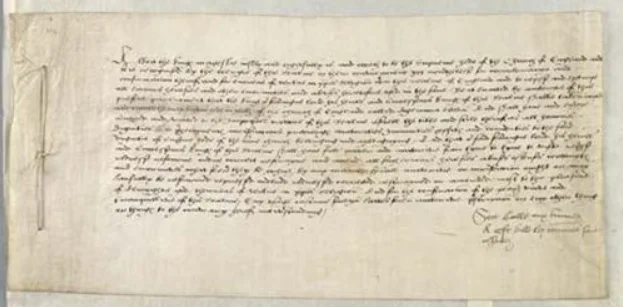 Henry VIII was in love with Anne Boleyn but was married with Catherine of Aragon. He did a petition to divorce but the Pope was against due to the religion. The Pope excommunicated the King married Anne Boleyn. It caused the break with the Roman Catholic Church and the schism happened. Henry VIII created the "Church of England" and became gradually the "Supreme Head of the Church of England" with his Act of Supremacy.
Henry VIII was in love with Anne Boleyn but was married with Catherine of Aragon. He did a petition to divorce but the Pope was against due to the religion. The Pope excommunicated the King married Anne Boleyn. It caused the break with the Roman Catholic Church and the schism happened. Henry VIII created the "Church of England" and became gradually the "Supreme Head of the Church of England" with his Act of Supremacy. -
Monasteries were disbanded and the Crown appropriared their income and land which had an effect of nationalisation. The valuables were confiscated and melted down. It had a huge impact on nuns and monks who lived there, on the social fabric of communities and on the clergy's finances.There were rebellions in Yorkshire and Lincolnshire which interrupted the dissolution process of the monasteries. It lasted 6 months and they were called the "Pilgramage of Grace".
-
During Mary I's reign, protestantism was confined to secrecy as heretics and they were burned. Over two hundred protestants went to the stake. Those who lasted were forced to leave the country and fled to the Continent.
-
 After the death of Mary I, Elizabeth became queen. She was an unmarried woman who was also called the "Virgin Queen". When she acceeded to the throne, she needed to prove her legitimacy as Queen and had to appease religious tensions after twenty-five years of religious change.
After the death of Mary I, Elizabeth became queen. She was an unmarried woman who was also called the "Virgin Queen". When she acceeded to the throne, she needed to prove her legitimacy as Queen and had to appease religious tensions after twenty-five years of religious change. -
 The Pope’s hostility to the Elizabethan religious
The Pope’s hostility to the Elizabethan religious
settlement was growing. He instructed English Catholics not to attend Anglican church services. He called Elizabeth “The so-called queen”, “a heretic favouring heretics”. He excommunicated Elizabeth, almost giving Catholics licence to kill her with the certainty that it would not be seen as a crime by Rome. -
 She was Elizabeth’s cousin, and was Elizabeth’s legitimate heir. She was close to France and Spain. To Catholics, she was the legitimate heir and represented hope for a return back to Catholicism. Many plots were prepared to replace Elizabeth by Mary Stuart. One of them is the Babington plot where their strategies were discovered by Francis Walsingham. He managed to decipher a coded letter between Marie Stuart and this group which led her to be excecuted for high treason.
She was Elizabeth’s cousin, and was Elizabeth’s legitimate heir. She was close to France and Spain. To Catholics, she was the legitimate heir and represented hope for a return back to Catholicism. Many plots were prepared to replace Elizabeth by Mary Stuart. One of them is the Babington plot where their strategies were discovered by Francis Walsingham. He managed to decipher a coded letter between Marie Stuart and this group which led her to be excecuted for high treason. -
 Elizabeth supported the Dutch Revolt against Spain. As a result, the King of Spain attempted to invade England. It was acomplete defeat and England was victorious. They had a material advantage. A new fleet was constructed: modern fleet of 800 ships.
Elizabeth supported the Dutch Revolt against Spain. As a result, the King of Spain attempted to invade England. It was acomplete defeat and England was victorious. They had a material advantage. A new fleet was constructed: modern fleet of 800 ships. -
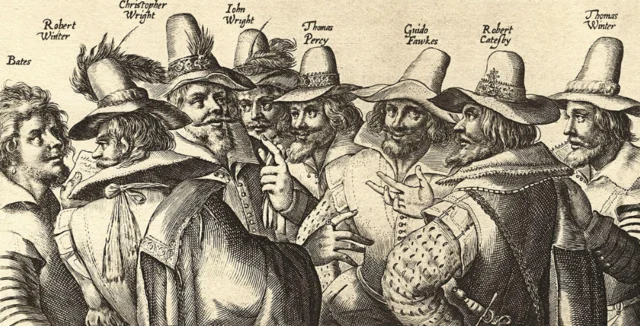 When James became King of England after Elizabeth I's death, Catholics placed high hopes in him because he was Queen Mary’s son, but James continued Elizabeth’s harsh repressive laws. This led to the Gunpower Plot : a conspiracy devised by a small group of Catholics to blow up Parliament and kill James I.
When James became King of England after Elizabeth I's death, Catholics placed high hopes in him because he was Queen Mary’s son, but James continued Elizabeth’s harsh repressive laws. This led to the Gunpower Plot : a conspiracy devised by a small group of Catholics to blow up Parliament and kill James I. -
The Starving Time was a period of starvation were only sixty of the five hundred colonists survived. There were a shortage of drinkable water, insufficient growing of crops and conflicts with the Native Powhatan tribe. Some settlers even turned to cannibalism.
-
Believing in peace between the Catholic and Protestant powers abroad, James arranged for his daughter Elizabeth Stuart to marry a Protestant prince of a part of Germany, and his son, Charles, to marry a Spanish Catholic princess. However, the Emperor sent his army. England finished at war with Spain and France. After James I's death, Charles I had to continue the war. In consequence, the war caused a huge strain on finances and the raising of troops had important impacts on the local population.
-
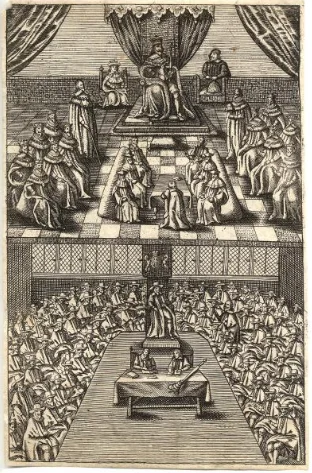 Needing money to fight the Scots, Charles called a parliament for the first time in eleven years (“The Short Parliament”). As the MPs demanded the King to address their grievances first, Charles dissolved it after only three weeks).The Scots invaded England and emerged victorious The Treaty of Ripon forced Charles to pay the cost of the Scots’ army which was considered as a humiliation. Charles had to call parliament again: “The Long Parliament” because it would not be dissolved until 1660.
Needing money to fight the Scots, Charles called a parliament for the first time in eleven years (“The Short Parliament”). As the MPs demanded the King to address their grievances first, Charles dissolved it after only three weeks).The Scots invaded England and emerged victorious The Treaty of Ripon forced Charles to pay the cost of the Scots’ army which was considered as a humiliation. Charles had to call parliament again: “The Long Parliament” because it would not be dissolved until 1660. -
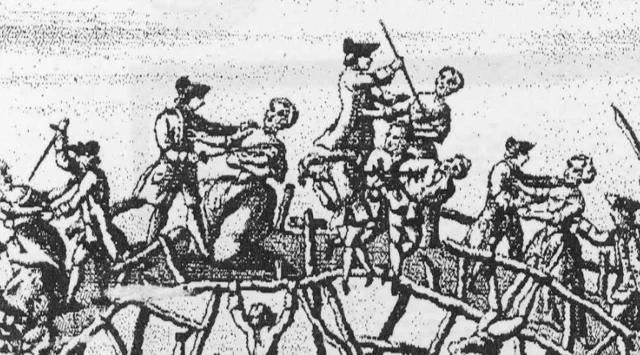 In October, an armed revolt broke out in Ireland. James I (Charles’ father) had implemented a plantation policy : sending English and Scottish protestant colonists to Ireland, taking the lands of Irish Catholics. However Irish Catholics rebels rose up against Protestant settlers which cause the massacre of three thousand to four thousand protestants.
In October, an armed revolt broke out in Ireland. James I (Charles’ father) had implemented a plantation policy : sending English and Scottish protestant colonists to Ireland, taking the lands of Irish Catholics. However Irish Catholics rebels rose up against Protestant settlers which cause the massacre of three thousand to four thousand protestants. -
The First civil war would cost the lives of hundred ninety thousand Englishmen and last for four years. It was the Royalists against the Parliamentarians. In May 1646 the King and the Royalists surrendered. Later, the King escaped from army custody and allied himself with the Scots. This led to the Second Civil War. It was made of a series of revolts in the South of England, Wales and Scotland. The Royalists were easily defeated by Cromwell. It started in January and finished in Autumn 1648.
-
In March, Monarchy and House of Lords abolished, England was declared a Commonwealth. A law abolished monarchy (described as “unnecessary, burdensome and dangerous”). The House of Lords was abolished. The House of Commons had supreme authority. England was declared a Commonwealth and ruled as a Republic. In 1653 the Commonwealth ended and the Protectorate started.
-
 After being declared guilty for high treason, King Charles I was executed. The regicide was welcomed with shock and dismay in England and Europe. It was reinforced by the Royalist propaganda describing the King as a martyr.
After being declared guilty for high treason, King Charles I was executed. The regicide was welcomed with shock and dismay in England and Europe. It was reinforced by the Royalist propaganda describing the King as a martyr. -
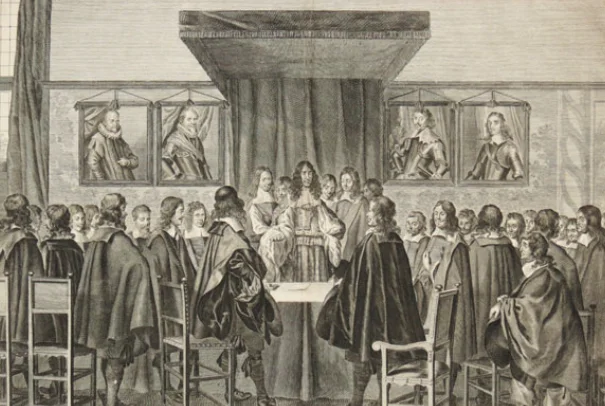 Charles II issued the Declaration of Breda. It promised: A general amnesty, to continue religious toleration, to share power with Parliament and in return for the restoration of monarchy. The King was restored in 29 May 1660. This period was called the Restoration.
Charles II issued the Declaration of Breda. It promised: A general amnesty, to continue religious toleration, to share power with Parliament and in return for the restoration of monarchy. The King was restored in 29 May 1660. This period was called the Restoration. -
The Parliament attempted to debar James II from the succession to the English throne. To this, Charles decided to dissolve the Parliament. James’ supporters were called the Tories, and James’ opponents were called the Whigs. The Tories supported the doctrine of hereditary rights, while the Whigs discredited by a plot to kill Charles.
-
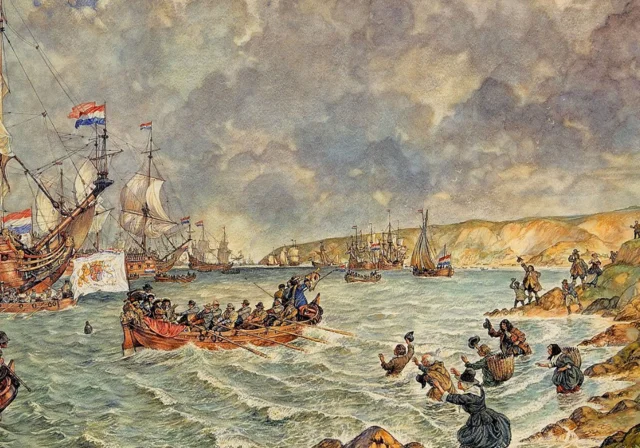 When James II sat on the throne, people were afraid of Catholic absolutism. James’ Heir was Catholic.The Parliament invited William of Orange to invade England and seize the crown.He landed with an army of fifteen thousand men and met no resistance. James’ army disintegrated and officers deserted.He fled to France and William became King William III. This Revolution shed no blood, liberties of English subjects were reinforced and it created a stable political system, the Constitutional Monarchy.
When James II sat on the throne, people were afraid of Catholic absolutism. James’ Heir was Catholic.The Parliament invited William of Orange to invade England and seize the crown.He landed with an army of fifteen thousand men and met no resistance. James’ army disintegrated and officers deserted.He fled to France and William became King William III. This Revolution shed no blood, liberties of English subjects were reinforced and it created a stable political system, the Constitutional Monarchy. -
The Georgian era is a period were all the kings that have reigned were called George. There were George I to V. During this period, party politics of party identities were borned (Whigs vs. Tories). There were also the birth of modern offices: Cabinet & Prime Minister, and the Government and the State became more powerful. It was also the time of the Development of literacy and the increase in quantity of printed material, the appearance of petitions, demonstrations, riots and voting (limited).
-
A turning point in British history, as the nation lost a huge part of its empire in the American War of Independence.This marked the end of what is now called the ‘First British Empire’.
-
 The Act of Union created the United Kingdom of Great Britain and Ireland. It merged the Parliament of Ireland into the Parliament of the United Kingdom.
The Act of Union created the United Kingdom of Great Britain and Ireland. It merged the Parliament of Ireland into the Parliament of the United Kingdom.